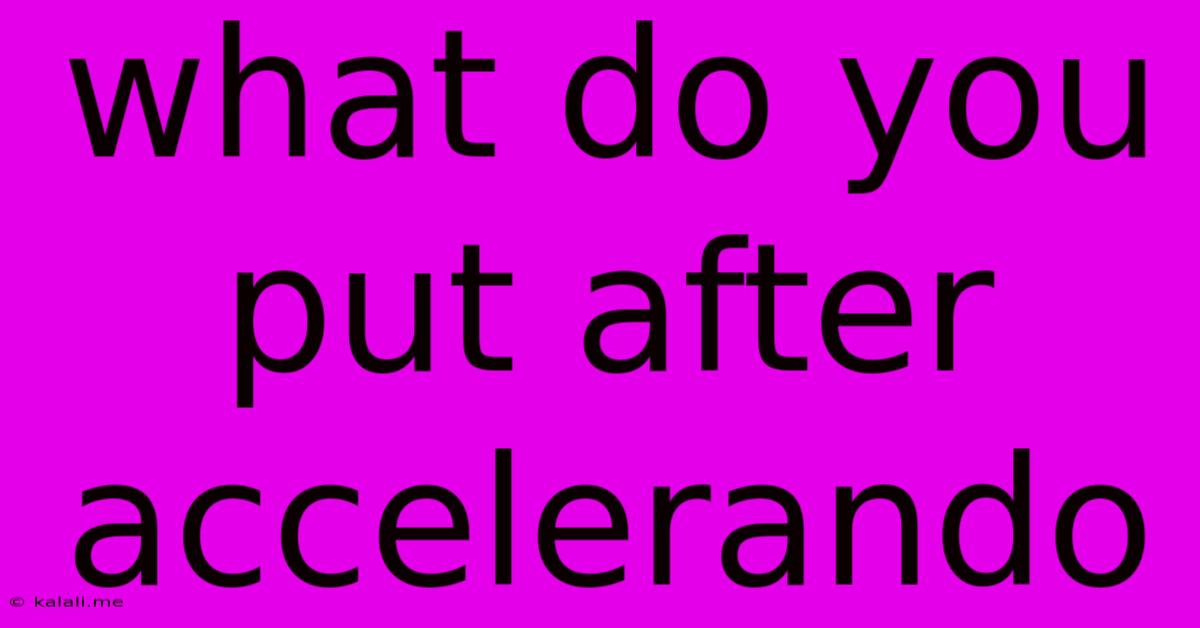What Do You Put After Accelerando
Kalali
May 24, 2025 · 3 min read

Table of Contents
What Do You Put After an Accelerando? A Composer's Guide to Seamless Transitions
So, you've built the tension, the music is surging forward, propelled by a powerful accelerando. But what comes next? Ending abruptly can feel jarring, while a simple return to tempo normale might feel anticlimactic. The transition after an accelerando is crucial for maintaining musical momentum and creating a satisfying listening experience. This article explores various techniques composers employ to smoothly navigate this crucial moment.
This guide will discuss several approaches to follow an accelerando, ensuring a natural and effective flow in your musical composition. We'll explore different musical devices and techniques to maintain the momentum built up by the accelerando. We'll also consider the context of the music and how the overall style influences the optimal transition.
Understanding the Context: The Importance of Musical Style
The ideal transition after an accelerando isn't a one-size-fits-all solution. The style of music significantly impacts the best approach. Consider these examples:
-
Classical Music: In a classical piece, a gradual ritardando following an accelerando might be appropriate, creating a sense of controlled release after the build-up. Alternatively, a sudden shift to a slower tempo could emphasize a dramatic change in mood or dynamic. Think of the dramatic shifts in tempo often found in Beethoven's symphonies.
-
Romantic Music: Romantic composers frequently used accelerandos to heighten emotional intensity. The transition might involve a shift to a more lyrical melody, a change in harmony, or a crescendo to maintain the emotional impact. Consider the soaring climaxes often found in the works of Tchaikovsky.
-
Jazz Music: In jazz, the transition might involve a rhythmic shift, a change in chord progression, or a solo improvisation that builds on the energy created by the accelerando. The improvisation might even maintain the accelerated tempo for a time before settling back down.
-
Modern and Contemporary Music: Modern and contemporary music offers even more freedom. The transition might involve abrupt tempo changes, unexpected rhythmic patterns, or even silence to create a powerful contrast or reflect the music's experimental nature.
Techniques for Smooth Transitions After an Accelerando
Several musical devices can create seamless transitions:
-
Ritardando: A gradual slowing down (ritardando) after an accelerando provides a natural and controlled release of tension. This allows the listener to absorb the emotional impact of the accelerando before moving on.
-
Crescendo/Diminuendo: Coupling the accelerando with a crescendo (gradual increase in volume) and then following with a diminuendo (gradual decrease in volume) can create a powerful and satisfying arc.
-
Change in Harmony/Melody: A shift in harmony or the introduction of a new melody can provide a natural transition point, effectively drawing attention away from the change in tempo.
-
Cadence: Using a strong cadence (a musical conclusion) after the accelerando can provide a sense of resolution and closure before moving to the next section.
-
Dynamic Changes: A shift in dynamics (loudness or softness) can be used to guide the listener's attention and smooth the transition.
-
Rhythmic Changes: Altering the rhythmic structure, perhaps by introducing syncopation or a new rhythmic motif, can help maintain the energy while creating a sense of change.
-
Pause or Fermata: A brief pause or the use of a fermata (a pause of indeterminate length) can provide a dramatic or contemplative break before continuing.
Beyond the Technical: Consider the Emotional Arc
Ultimately, the best transition after an accelerando depends on the overall emotional arc of your piece. The accelerando itself likely serves a specific emotional purpose; your transition should complement that purpose. Does the music need to retain its energy? Does it need to become more contemplative? Does it need to reach a peak of emotional intensity and then resolve? Answering these questions will guide you towards the most effective transition.
By thoughtfully considering the musical style, employing appropriate techniques, and understanding the emotional context, you can craft seamless and powerful transitions after an accelerando, resulting in a more compelling and satisfying musical experience for your listeners.
Latest Posts
Latest Posts
-
Best Program To Write A Book With Pictures
May 24, 2025
-
Blender Match Scene World Lighting To Viewport
May 24, 2025
-
How To Increase Pcdc Speed On Ra6m2
May 24, 2025
-
How To Find Image Of A Matrix
May 24, 2025
-
Power Series Of 1 X 1 X
May 24, 2025
Related Post
Thank you for visiting our website which covers about What Do You Put After Accelerando . We hope the information provided has been useful to you. Feel free to contact us if you have any questions or need further assistance. See you next time and don't miss to bookmark.